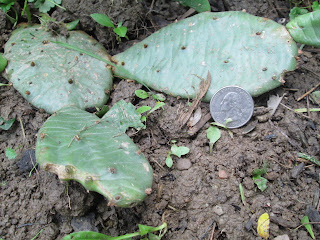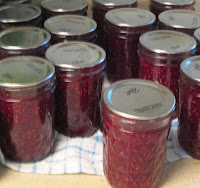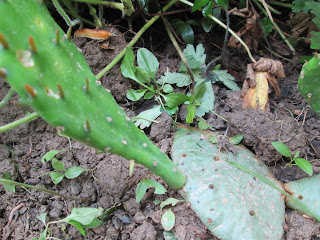 |
| Hopefully by next year the quarter will seem small |
An Eastern United States
Native Cactus
Eastern Prickly Pear Cactus (opuntia humifusa) the only native Ohio cactus was a gift from my market friend Lilly. I had no idea that Ohio, even had a perennial cactus. As it turns out we certainly do!
Eastern Prickly Pear or Devil' s Tongue as it is sometimes referred to, has a wide natural range; spreading from Colorado east, and as far north into Ontario, Canada were it is listed as endangered. The USDA Natural Resources Conservation Services list additional concerns in the states of: Connecticut, New York, Massachusetts and Vermont.
Native Ground Cover

Eastern Prickly Pear Cactus
The blooming cycle for this member of the Cactus family (Cactaceae) is rather unusual, each flower lasting 24 hours. Once this plant is established is spreads easily, providing a month's supply of nectar and pollen for visiting bees.
I planted mine in a sunny, dry section of my front yard. With a maximum height of 18 inches and the potential to spread 30 inches, I felt it would make a perfect native plant ground cover, eventually replacing my 20 years worth of Creeping Myrtle. Although I am not proud of the fact that I have invasive plants growing in my yard, the process of eradicating 20 years worth of uneducated choices takes both time and energy.
 |
| My Prickly Pear Cactus |
Not Just a Ground Cover
Back in the early 1980's, on one of our "Spring Training Trips" to see the Cleveland Indians play (we lived in Denver, Colorado, USA) my husband and I had a deal one day of baseball in exchange for one day of site seeing, I chose the Arizona-Sonora Desert Museum. The thing I remember most about the museum was the diverse and significant roles cactus played for both wildlife and those who inhabited the area. This got me thinking.
Could I eat, drink, or create something with Prickly Pears?
I discovered, the answer was yes to all three questions.
People from Mexico and Central America have been dinning on Prickly Pears, Opuntia species for thousands of years, three sections of the cactus are edible; the first is the pad or the nopal, this is the part that looks like a beaver's tail. The second is the fruit which is referred to as tuna and the third is the flower. Of course cactus like the Opuntia ficus-indica, which inhabits Arizona, USA are growing under ideal conditions producing an abuncance of fruit.
The spines in cactus like the Engelmann prickly pear cactus Opuntia engelmannii are 3" long, were once used as sewing needles. Our eastern version spines aren't long enough for stitching; tread (or thread) lightly as they still rather sharp. The juice from this plant is very popular beverage, research is being performed on the possibility of the sugars aiding in the control of diabetes and high cholesterol. Historically, this plant has been used to treat numerous aliments from burns to rheumatism. My favorite use, Prickly Pear Jam.
Prickly-Pear- Jam
I wondered how many plants I would need to make 14 jars of prickly Pear Jam? I found the answer on the blog post Mostly Photos, this is a fun post that includes wonderful images.
I am fairly certain that our Eastern Prickly Pear tuna is not as robust as those used in Megan's blog, however I trust it gives you an idea as to how versatile this species truly is.
 |
| My Raspberry Jam |
Prickly Pear Jam
50 prickly pear fruits
4 maybe 5 cups of sugar
2 cups water (to boil seeds in)
Juice of 2 lemons and 1 grated lemon rind
1 (Net Wt. 1.75 OZ) package pectin
"How Do You Harvest Prickly Pears?
Very Carefully!
 |
| Wearing gloves would have been a nice idea! |
It is very obvious that the spines on the cactus are sharp. In formation on Wikki - How to Eat- Prickly-Pear Cactus suggests wearing gloves and cutting the napols off with a knife; this reduces the stress on the plant.
Lilly warmed me to wear gloves when planting this spiny little fellow, I learned the hard way and wished I had heeded her advice. Picking a sweet ripe tomatoes off the vine or a prickly pear, which would you choose?
Prickly Pears at the Frostville Farmer's Market?
Maybe I can add cactus jelly to my market inventory. Either way I decided to get started and ordered Prickly Pear Cactus seed from Prairie Moon Nursery. My cactus is young and may not bloom this season. If you would like to see pictures of this lovely plant visit Natural Treasure of Ohio blog. This is an informative post with fabulous photos. | |||||||||||||


I have seen Prickly Pear Cactus growing in a garden nearby to me here in Connecticut. Now that you have provided me with great information on it, I would love to try growing my own. That jam sure sounds delicious to me! I also like the challenge of growing a native plant that I am so amazed can survive our harsh winters!
ReplyDeleteI remember being surprised that we had a native cactus as well. I can't remember when I learned about it, but I was surprised to find some growing in the "traditional" flowerbeds of the house we bought. Those flowerbeds are being reworked as I transform the property into a native habitat. The few natives I've found already growing here are being propagated.
ReplyDeleteI'm trying to figure out how best to use the prickly pear. I'd love to see it out in nature and mimic that here.
When you do figure it out, please let me know. I am trying to grow it from seed, two little seedlings so far!
ReplyDeleteI stopped dead in my tracks this morning while out on a run, there hiding under a fence were ( I believe) two patches of Prickly Pear.